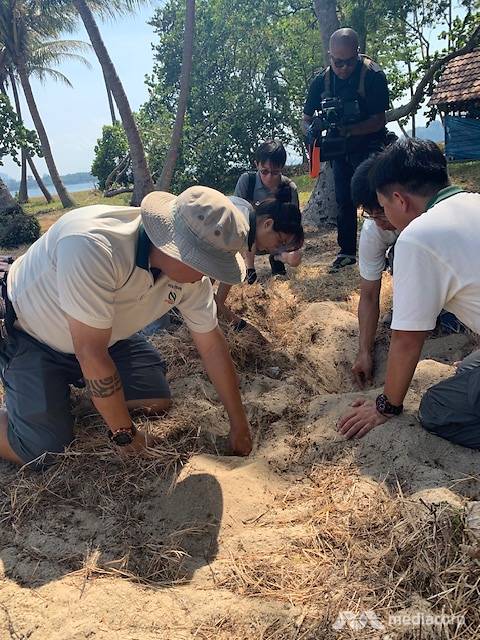SINGAPORE: About 150 baby turtles were hatched last year at Singapore’s first and only hatchery for these marine creatures, the National Parks Board (NParks) said on Wednesday (Aug 21), nearly a year since its official launch in September 2018,
The turtle hatchery at Sisters’ Islands Marine Park was built as part of efforts to provide a safe space for incubating eggs, which faces threats caused by human traffic, light pollution and predators such as monitor lizards.
Singapore is home to two species of turtles: the hawksbill turtle and the green turtle, both of which are critically endangered.
The turtles visit various shores around Singapore to lay eggs during the nesting season from May to October. Each nest contains between 100 and 200 eggs.
Each turtle nest contains about 100 to 200 eggs. (Photo: Junn Loh)
When CNA visited a hawksbill turtle nest along East Coast Beach on Wednesday morning, a clutch of 152 eggs were recorded.
Of those, 98 eggs were relocated to NParks’s hatchery on Small Sister’s Island. The rest of the eggs were not relocated as they had not developed.
NParks said the decision to move the eggs was due to its close proximity to a construction site, which is brightly lit at night. Volunteers patrolling the shores have also reported sightings of hatchlings near the area.
Turtle eggs collected and placed in a bucket at a hawksbill turtle nest along East Coast Beach. (Photo: Junn Loh)
Baby turtles instinctively move toward the sea, guided by lights from the horizon when they hatch. Light sources from urban environment could confuse the hatchlings, which may attract them to crawl inland instead of out into the waters.
In contrast, the hatchery at the protected Small Sisters’ Island is off-limits to the public and free from excessive light pollution.
The rescued eggs will be left to incubate and monitored within cages on the island until the baby turtles emerge. They will also be protected against predators such as monitor lizards, increasing hatching success.
Members of the public have been roped in to help with the cause. Volunteers from a team called the Biodiversity Beach Patrol are trained on how to protect nesting turtles, and how to spot turtle tracks on the shores, for example.
“We spend the entire night as a group combing the different areas that we’re allocated to,” said volunteer Bernard Seah.
Volunteers are trained on how to protect nesting turtles, and how to spot turtle tracks on the shores. (Photo: Junn Loh)
The group typically splits into teams of two or three, working in alternating six-hour shifts during nesting season.
“If we see turtle tracks, we just report it. But if we see turtle activities, we see a female turtle nesting, or we see hatchlings, we call NParks straight away, and we will activate them to come down to the site to take over,” Mr Seah said.
There were 62 reported turtle sightings and 10 successful nests of hatchlings recorded across Singapore in 2018.

Volunteers patrol the shores to spot and protect turtle nests. (Photo: Junn Loh)
But even as conservation efforts to protect native rare sea turtles bear fruit, Senior Manager of the NParks Coastal and Marine Team Collin Tong said threats caused by marine pollution and human activities remain even after the turtles find their way into the sea.
“Things like plastic bags, especially the translucent ones. They look like jelly fishes to the turtles.” Mr Tong said.
“So it will be good if people try to be more aware. Make sure things don’t fly into the sea, and don’t intentionally drop things into the waters. That will help conserve the marine habitats which all these critically endangered turtles live in,” he added.




